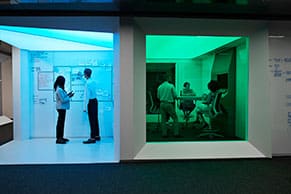When people think about running a business, they often focus on the final product — the moment when customers walk away with exactly what they want. And while customer satisfaction is the ultimate goal, two crucial forces make it all possible: supply chain and procurement. The supply chain covers the entire product journey from the point where businesses secure raw materials from suppliers to the shipping of final products to customers. Procurement, on the other hand, is a subset of the supply chain that zeroes in on the acquisition of the right materials at the right price to fuel production.
The two concepts might seem interchangeable at a high level, but to anyone keen on operating a successful business, understanding the key differences between them is essential. This article explores each process, highlighting key similarities and differences, as well as how supply chain and procurement can work in harmony to keep businesses running smoothly and customers satisfied.
What Is the Supply Chain?
The supply chain is the essential, behind-the-scenes engine that drives the transformation of raw materials into finished products and gets them into consumers’ hands. At its heart, supply chain management (SCM) orchestrates the flow of goods, services, information and finances through every stage of production — from sourcing and manufacturing to transportation, warehousing and distribution.
It’s an increasingly important component of most businesses. According to Fortune Business Insights, the global supply chain management market was valued at $23.5 billion in 2023 and is projected to grow to $63.7 billion by 2032. But it involves much more than just moving goods from point A to point B. SCM is a dynamic, interconnected network where suppliers, manufacturers and distributors work together in a carefully coordinated process.
SCM begins with sourcing, where finding the right materials at the right price sets the foundation for success. From there, production takes over, managing the transformation of raw materials into valuable end products. The logistics of getting those materials and finished goods to their next destination — whether that’s a factory, warehouse or customer — is another critical component, incorporating transportation, warehousing and, potentially, returns. Ultimately, SCM manifests as a strategic effort to lower costs, improve efficiency and meet customer demand. Success hinges on flexibility and resilience, as market fluctuations, supplier issues and unexpected disruptions are inevitable. Good SCM builds resilience into the process, keeping operations running smoothly even when the unexpected strikes.
What Is Procurement?
Procurement is a key part of the supply chain process, one that focuses on acquiring the resources a business needs to operate — whether that’s raw materials, services or technology. More and more businesses are turning to procurement technology to optimize operations. In fact, Fortune Business Insights predicts the market for procurement systems will grow from $7.30 billion in 2023 to $18.28 billion by 2032.
It’s not just about buying stuff, however. Procurement is the strategic process of sourcing the right materials from the right suppliers, negotiating the best deals, and managing supplier relationships to keep costs low and value high. According to Deloitte’s 2023 Global Chief Procurement Officer Survey, 71% of respondents listed improved margins through cost reduction as a top priority.
The procurement process starts with identifying the operational and strategic needs that are essential for a business to function effectively and achieve its goals. The next step is finding the best suppliers to meet those needs, often through a careful evaluation of quality, price and reliability. Once suppliers are chosen, it’s time to negotiate. This is where procurement professionals earn their paychecks, securing favorable terms, often with long-term contracts that provide stability for both the company and the supplier. But the process doesn’t end when the contract is signed. Procurement professionals must manage supplier performance to keep deliveries on time while handling issues as they arise. Other key elements of the procurement process include controlling costs, maintaining a balance between quality and price and building strong supplier relationships.
Like supply chain management, procurement is all about strategy, flexibility and resilience. When market conditions change, procurement teams must adapt to find new suppliers or renegotiate terms to keep operations running smoothly.
Key Takeaways
- SCM coordinates the flow of goods, services, information and finances through every stage of production.
- Procurement focuses on acquiring the resources a business needs to operate.
- The difference between the two lies in the fact that the supply chain oversees the broader process of moving goods through the system, while procurement focuses on sourcing raw materials.
- Both functions aim to create smooth operations and cost efficiency.
- Key best practices for integrating SCM and procurement include building cross-functional teams, establishing joint performance metrics and using integrated technology platforms.
How Do Supply Chain and Procurement Impact Decisions?
Procurement management and SCM each influence the other in ways that can reverberate throughout a business. When procurement selects a supplier, it lays a foundation for the entire supply chain. The supplier’s reliability, incumbent costs and level of quality can have a ripple effect on production processes, affecting everything from timelines to customer satisfaction. In worst-case scenarios, choosing the wrong supplier could result in a complete halt in operations.
On the flip side, supply chain requirements also shape how procurement operates. For example, if the supply chain is stretched thin due to logistical issues, such as multiple stops and long distances, procurement could prioritize finding local suppliers to speed things up. Similarly, if the goal is to cut down on inventory costs, procurement might need to source suppliers that can deliver smaller, more frequent shipments rather than bulk orders. It’s a constant push and pull. The faster the supply chain needs to move, the more procurement must find quick, reliable suppliers. If the focus is on cutting costs, procurement shifts gears to find cost-efficient, long-term partnerships.
Supply Chain vs. Procurement: 7 Key Differences
While procurement primarily deals with supplier relationships, contract negotiations and purchasing activities, SCM takes a more holistic view of the entire value chain from raw materials to final delivery. In essence, procurement can be seen as a crucial subset of SCM, playing a vital role in sourcing the inputs needed for the supply chain to function smoothly. Understanding this distinction is important for businesses looking to optimize their operations, as effective procurement practices contribute significantly to the overall efficiency and success of the supply chain. In this section, we compare and contrast supply chain and procurement in seven key categories.
-
Scope and Focus
Procurement concentrates on the acquisition of goods and services from external suppliers, while supply chain management encompasses the entire process, from sourcing raw materials to delivering finished products to customers.
- Supply chain: The supply chain manages the entire journey of a product, from sourcing raw materials to delivering the final item to customers. Picture smartphones: Their components, such as chips and screens, are sourced from various global suppliers, and the phones are assembled in different locations and then distributed worldwide. The focus here is on coordinating every link in the chain, including production, transportation and warehousing.
- Procurement: Procurement, while a key part of the supply chain, focuses more narrowly on the initial stage — acquiring the right goods and services to keep operations running. In the case of a smartphone, procurement’s job is to secure contracts for the microchips or steel used in the phone’s components. Procurement concentrates on finding reliable suppliers, negotiating prices and maintaining those relationships central to fueling the larger supply chain.
-
Process and Activities
Procurement involves activities like sourcing, negotiating, and purchasing, whereas the supply chain manages the end-to-end flow of goods and services, including procurement, production, logistics, and distribution.
- Supply chain: The supply chain process is a finely tuned operation, overseeing logistics, inventory management, demand forecasting and more. Imagine orchestrating the delivery of popular holiday products: mapping out efficient shipping routes, balancing stock levels across warehouses and predicting customer demand. The goal is to keep the flow of goods running smoothly so the right products reach the right customers at exactly the right time.
- Procurement: Procurement, on the other hand, is where the groundwork is laid. It’s about sourcing the right materials and negotiating deals before anything can move. Take the holiday product example: Procurement’s role is to secure the raw materials — whether it’s fabric for clothing or microchips for electronics. The focus is on building strong supplier relationships and locking in the best prices so the supply chain has everything it needs to run efficiently.
-
Objectives
The main goal of procurement is to secure quality products at the best price, ensuring timely delivery, while supply chain management aims to optimize the entire flow of operations to improve efficiency, reduce costs, and enhance customer satisfaction.
- Supply chain: The objective of the supply chain is to optimize the entire flow of goods and services, maximizing efficiency at every step. It’s focused on making sure products move smoothly from suppliers to customers and streamlining the production and delivery of a product line in a way that reduces costs, avoids delays and meets demand. SCM keeps the whole operation running like clockwork, with minimal bottlenecks.
- Procurement: Procurement’s main objective is to acquire the right goods and services at the best possible price and quality. For example, procurement’s goal when sourcing materials for a new product is to strike a balance between cost and reliability so the business gets the best bang for its buck. It’s not just about finding the cheapest option; it’s about finding the highest quality at the most competitive rate.
-
Time Horizon
Procurement tends to be more short-term and transaction-focused, dealing with immediate purchasing needs, whereas supply chain management has both short- and long-term perspectives, focusing on operational and strategic planning.
- Supply chain: Think of the supply chain as the master planner that always thinks about the future and lays the groundwork for what’s coming next. As a company prepares to break into new international markets, for example, the supply chain team focuses on building a global network of suppliers that can scale production for years to come. The key is building long-term efficiency so the entire system can adapt and grow as demands change.
- Procurement: The procurement life cycle, by contrast, lives in the present. It’s all about acquiring what’s needed today to keep things moving. For example, if a factory runs low on raw materials for the next month’s production, procurement steps in to secure those supplies, with the best deal and fastest delivery. Procurement doesn’t ignore cost and quality, but it’s laser-focused on handling the immediate needs of the business.
-
Decision-Making
Decision-making focuses on more tactical functions like supplier selection, contracts, and pricing. On the other hand, supply chain decisions are broader, involving strategic considerations like inventory management, logistics, and overall network optimization.
- Supply chain: Supply chain decisions are like moves on a chessboard, with each move creating repercussions across the entire network. Say a company decides to centralize its warehouses to cut down on shipping costs. The decision doesn’t just impact warehouses; it also affects delivery times, inventory levels and, potentially, customer satisfaction. Supply chain decisions must balance efficiency, cost and the ability to adapt to shifting demand, all while keeping the whole operation running smoothly.
- Procurement: Procurement’s decision-making, meanwhile, is all about the finer details, such as choosing the right suppliers, negotiating favorable contract terms and locking in the best prices. For example, when a business needs to source materials for a new product, procurement decides which supplier offers the best combination of quality and cost and negotiates terms that will support the company’s production goals.
-
Metrics and Measurement
Procurement tends to focus primarily on cost savings, supplier performance, and contract compliance, whereas the scope of supply chain includes measuring a wider range, such as total costs, lead times, customer satisfaction, and efficiency of the entire system.
- Supply chain: Supply chain performance revolves around how fast, smoothly and reliably a company’s entire operation runs. Consider a business that tracks order fulfillment rates to see how quickly products move from the warehouse to the customer’s doorstep, for example. Another key metric for supply chain is inventory turnover, which measures how often stock is sold and replaced. A high turnover rate means the supply chain works efficiently to meet demand without hanging on to excess inventory.
- Procurement: Procurement’s success is measured by cost control and supplier performance. For example, a company might track cost savings from negotiated contracts, determining how much money they save by getting materials at lower prices or for more favorable terms. Procurement cycle time, another key metric, measures how quickly procurement teams can source, negotiate and deliver necessary materials. Supplier performance is also crucial — procurement teams need partners that deliver quality goods on time.
-
Integration and Collaboration
Procurement mostly involves suppliers collaborating with departments like finance and legal, while supply chain management requires coordination across multiple internal and external functions such as suppliers, manufacturers, logistics providers, and customers.
- Supply chain: The supply chain is a web of interconnected functions that rely on each other to keep a business operating. SCM requires tight coordination among procurement, production, logistics and sales teams. For example, if demand for a product spikes, the supply chain team has to collaborate with procurement to make sure there are enough raw materials on hand, with production to ramp up manufacturing and with logistics to guarantee faster delivery. Every piece of the puzzle has to work in lockstep to deliver the final product.
- Procurement: Procurement’s collaboration is more precise, primarily revolving around suppliers and internal stakeholders. Procurement teams build strong relationships with vendors to secure the best deals, and they work closely with other teams, such as finance, legal and operations, to make sure purchases align with the company’s needs. For example, when a new product is in development, procurement must coordinate with engineers to understand material requirements and then negotiate with suppliers to source those materials at the best price and quality.
7 Similarities Between Supply Chain and Procurement
Despite their differences, supply chain and procurement strategies also have a fair amount in common. Both aim to create smooth operations and cost efficiency. In addition, both rely on data, collaboration and strategic planning to optimize processes and meet customer demand. Let’s take a deeper dive into seven similarities between the two functions.
- Operational efficiency: Operational efficiency is core to both SCM and procurement. The supply chain team fine-tunes the flow of goods, including mapping out the quickest delivery routes and making sure inventory doesn’t sit idly on shelves. For procurement, efficiency comes from securing top-quality materials at the best prices and locking in deals that speed up the purchasing process. Together, they serve as a well-oiled machine, with procurement lining up the perfect suppliers and the supply chain seamlessly moving those goods for just-in-time production.
- Cost management: When it comes to cost management, both supply chain and procurement are playing the same game, just on different fields. The supply chain is focused on squeezing savings by optimizing logistics, managing inventory wisely and cutting out inefficiencies. Meanwhile, procurement negotiates killer deals, secures favorable terms and finds the best suppliers for the money. Picture procurement scoring savings on raw materials and the supply chain moving those materials through the system with minimal waste.
- Supplier relationships: Supplier relationships are at the heart of both supply chain and procurement, but each function nurtures those partnerships in unique ways. Procurement builds the foundation, negotiating terms, creating trust and making sure suppliers deliver high-quality goods at the right price. Then, the supply chain takes those relationships further by coordinating with suppliers for timely deliveries, consistent quality and long-term partnerships. Procurement essentially sets the stage with suppliers, and the supply chain keeps those partnerships thriving by making sure everything flows smoothly.
- Strategic planning: Strategic planning is another area where supply chain and procurement join forces. The procurement process lays the groundwork, developing strategies to source the best materials, negotiate long-term contracts and build a reliable network of suppliers. Supply chain, for its part, takes a broader strategic view, planning how to move those materials efficiently, scale operations to meet demand and anticipate potential disruptions.
- Risk management: Risk management is a shared priority for both supply chain and procurement. Procurement focuses on mitigating risks by diversifying suppliers, negotiating flexible contracts and having a backup plan should a vendor fall through. Meanwhile, the supply chain keeps its eye on potential disruptions, whether they’re natural disasters, transportation issues or supply shortages; builds contingencies; and adjusts operations to keep things running smoothly. Think of procurement as weaving a safety net by securing reliable sources, while the supply chain is constantly scanning the horizon for storm clouds, ready to pivot if needed.
- Data utilization: When it comes to data, supply chain and procurement rely heavily on data-driven insights to drive smarter decisions. Procurement teams use data to analyze supplier performance, track spending and identify cost-saving opportunities, making sure they’ve chosen the best partners and prices. The supply chain organization leverages data to optimize inventory levels, forecast demand and streamline logistics. While procurement focuses on making data-driven sourcing decisions, the supply chain uses that data to keep operations humming along.
- Integration with business operations: Supply chain and procurement are both deeply intertwined with broader business objectives. Procurement acts as a gatekeeper, providing the business with the materials and services it needs to function, such as securing steel so a car manufacturer can hit its production targets. The supply chain then integrates these materials into the overall process and coordinates all phases, from production schedules to delivery timelines.
Benefits of Aligning Supply Chain and Procurement
Bringing supply chain and procurement into alignment unlocks a whole new level of efficiency and collaboration. When the two work in harmony, companies can cut costs, make smarter decisions and adapt quickly to changing demands. Here are the most common benefits of bringing supply chain and procurement into sync.
- Improved cross-departmental planning: When supply chain and procurement work together, cross-departmental planning becomes an operational dream. For example, when procurement shares real-time updates on supplier lead times, the supply chain can immediately adjust production schedules and inventory levels without missing a beat. This allows every department to stay ahead of the curve and make smarter decisions.
- Increased data transparency: Aligning supply chain and procurement provides data transparency and visibility that create a clearer view of operations from end to end. When procurement shares insights about supplier performance or material costs, the supply chain can use that data to optimize logistics, forecast demand or adjust production. Both teams can see what’s happening in real time, leading to quicker decisions, fewer bottlenecks and more efficient operations.
- Supplier streamlining: Close collaboration between supply chain and procurement can lead to smarter, more streamlined supplier management. Procurement can identify which suppliers offer the best value, while the supply chain team assesses how well those suppliers fit into the overall operational flow. For instance, instead of juggling multiple vendors for the same material, collaboration might reveal an opportunity to consolidate suppliers to cut costs and simplify logistics. The result is a more effective, focused network of suppliers that supports both teams’ goals.
10 Best Practices for Integrating Supply Chain and Procurement Strategies
Integrating supply chain and procurement requires more than mere collaboration; it takes smart strategies and careful planning. By following these 10 best practices, companies can strengthen the connection between the two processes to reveal greater efficiency and performance.
-
Build Cross-Functional Teams
Cross-functional teams are the secret sauce for seamlessly blending supply chain and procurement strategies. When these teams come together, they break down silos, align objectives and build a more agile operation that can solve problems quickly and adapt to changes. Procurement can share insights on supplier negotiations, for example, while the supply chain team can adjust logistics for better efficiency. Consider bringing finance and IT into the mix to give the team a fresh perspective on budgets and data infrastructure. And be sure to keep communication constant and open, with everyone pulling in the same direction.
-
Define Shared KPIs
The process of defining shared key performance indicators (KPIs), such as cost savings or on-time delivery rates, is where the magic happens between supply chain and procurement. It’s about sitting down together to determine what success looks like for both sides — perhaps that’s reducing costs, improving delivery times or boosting supplier reliability. The process starts with an understanding of the priorities for each team and finding the sweet spot where their goals overlap. For example, procurement might be focused on negotiating the best deals, while the supply chain wants timely deliveries — so a shared KPI could be supplier lead time. The real power of shared KPIs is that they encourage both teams to speak the same language, track the same targets and celebrate wins together. It’s not just about measuring performance; it’s about building a partnership.
-
Codevelop Policies, Processes and Standards
When supply chain and procurement teams codevelop policies, processes and standards, they create a unified playbook that keeps everyone on the same page. This goes beyond simply writing rules; it includes building a framework that maintains consistency, efficiency and flexibility across both functions. Imagine both teams coming together to design a supplier onboarding process that meets procurement’s need for cost efficiency and the supply chain’s focus on reliability and speed. By developing standards collaboratively, the teams avoid misalignment and deflect friction in day-to-day operations.
-
Leverage Tools and Software Solutions
The right software gives supply chain and procurement teams a high-tech toolkit to streamline every step of their collaboration. According to a 2024 report from MHI and Deloitte, 55% of respondents said they plan to increase investments in emerging SCM technologies. With software designed to integrate both functions, teams stay aligned on everything from tracking orders to managing suppliers and forecasting demand. For example, an AI-powered platform can alert procurement to price changes while simultaneously adjusting supply chain forecasts to match. The result is supercharged efficiency that allows both teams to react faster, work smarter and reach better results.
-
Use Integrated Technology Platforms
In addition to leveraging technology, using integrated technology platforms is also critical. When supply chain and procurement teams connect through a unified platform to track inventory, manage suppliers or analyze data, collaboration becomes seamless. Procurement can place an order and the supply chain instantly sees updated inventory levels and delivery timelines. This kind of real-time visibility cuts down on miscommunication and speeds up decision-making. A growing number of companies use enterprise resource planning (ERP) systems as a core integrated platform to combine functionality for SCM, procurement and finance operations and create a unified view of data across departments.
-
Foster Collaborative Technology and Data Sharing
When supply chain and procurement teams truly embrace collaborative technology and data sharing, it’s like giving them a crystal ball. With real-time data at their fingertips to help probe everything from supplier performance to inventory levels, they can address problems before they arise. Procurement can spot a potential supply delay and instantly share it with the supply chain, which can then reroute logistics to keep everything on track. This constant flow of shared data builds trust and speeds up decision-making.
-
Enhance Supplier Relationship Management
Building strong supplier relationships is central to both supply chain and procurement success, and aligned efforts can make those connections even more powerful. When procurement develops close ties with suppliers, it creates opportunities for better deals, faster service and more flexibility. And when the supply chain team joins forces with procurement, it adds an extra layer of insight, such as disclosure on how well those suppliers meet delivery timelines or handle unexpected demand spikes. This combined approach deepens trust with key suppliers. As a result, they move beyond being vendors to become long-term partners that understand the full scope of a business’s needs.
-
Share Knowledge and Best Practices
When supply chain and procurement teams actively share knowledge and best practices, it sparks new ideas and smooths out potential blind spots. Procurement might offer insights on negotiating better contracts, while the supply chain team knows how to optimize logistics for faster delivery. Bringing these insights together creates a stronger, smarter strategy. For example, procurement could learn from the supply chain how to spot early signs of potential supplier delays. By the same token, the supply chain can benefit from procurement’s knack for identifying cost-saving opportunities. It’s a cycle of learning that pushes both teams to operate more efficiently and stay ahead of challenges.
-
Implement Training and Professional Development
Investing in training and professional development for supply chain and procurement teams creates a foundation for long-term success. When these business functions understand each other’s challenges and processes, they’re better equipped to collaborate effectively. For example, teaching procurement about the intricacies of logistics or giving the supply chain team a primer on supplier negotiations opens up new ways to improve efficiency. Cross-training builds empathy and a shared language, so it’s easier to meld goals and strategies.
-
Align Reporting Structures
Aligning reporting structures between supply chain and procurement breaks down silos and encourages a more unified approach to decision-making. When both teams report through the same leadership or share KPIs, goals and priorities become easier to unify. For example, if procurement and supply chain both report to a single operations lead, there will be a clearer line of communication, so decisions on sourcing, logistics and inventory can all support the overall business strategy. This kind of structure fosters collaboration and reduces conflicts.
Integrate Supply Chain and Procurement With NetSuite
NetSuite offers a seamless way for small to midsize businesses to integrate their supply chain and procurement processes within a single ERP platform. Its two solutions, NetSuite Supply Chain Management and NetSuite Procurement, work together seamlessly to give companies complete control over their operations, from sourcing materials to delivering finished goods. NetSuite’s SCM capabilities extend beyond traditional logistics, offering robust tools for demand planning, inventory management and production scheduling. Meanwhile, the procurement module allows businesses to manage supplier relationships, track purchase orders and simplify contract negotiations — all while keeping supply chain teams in the loop with real-time updates.
NetSuite’s SCM and procurement solutions are part of its broader, cloud-based ERP platform that includes modules for financial management, human resources and manufacturing. With supply chain and procurement seamlessly connected to financials, inventory and customer orders, businesses can improve accuracy, reduce errors and respond more quickly to changing market conditions. Being cloud-based means that procurement and supply chain team members can access data anytime, anywhere, without the need for complex on-site infrastructure. It also guarantees automatic updates and scalability as businesses grow, without costly upgrades or disruptions.
In the end, supply chain and procurement are two sides of the same coin, each essential to keeping a business running smoothly but with distinct roles to play. Success comes from aligning them to work in harmony and drive value. By understanding their differences and how they complement each other, companies can ultimately unlock greater efficiency and stronger performance.
#1 Cloud ERP
Software
Supply Chain vs. Procurement FAQs
What is the procurement cycle in supply chain?
The procurement cycle in the supply chain is the process of identifying, acquiring and managing the goods and services a business needs to operate. It begins with identifying requirements and moves through supplier selection, order placement and receiving goods. The cycle ends with payment and post-purchase evaluation. This process ensures that the right materials are obtained at the right price to keep the supply chain running smoothly.
Are purchasing and procurement the same?
Purchasing and procurement are related but not the same. Procurement is a broader term that describes the entire process of sourcing, negotiating and acquiring goods or services. It involves strategic activities, such as supplier relationship management and contract negotiation. Purchasing, on the other hand, is a subset of procurement, focused specifically on the transaction of buying goods and services.
What is the role of procurement in supply chain?
Procurement plays a critical role in the supply chain by sourcing and acquiring the goods and services needed for production and operations. When done effectively, materials are available at the right time, for the right price and presenting the right quality, helping maintain the flow of goods. Procurement also manages supplier relationships, negotiates contracts and controls costs, contributing to overall supply chain efficiency. It’s a strategic function that’s essential for minimizing disruptions and optimizing resources throughout the supply chain.









